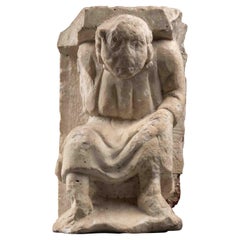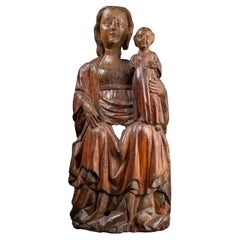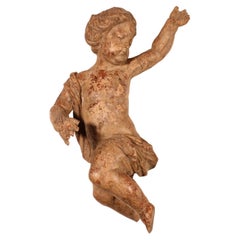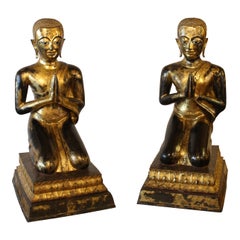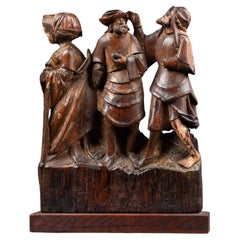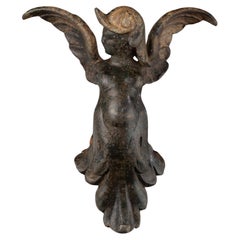Brussels Figurative Sculptures
to
20
84
3
48
12
24
3
4
7
3
2
1
2
1
9
5
3
2
2
2
1
1
1
29
26
21
18
17
7,738
7,607
72
33
18
13
4
Height
to
Width
to
87
84
84
3
3
2
1
1
Item Ships From: Brussels
Romanesque Telamon - Northern Italy, late 12th (Reemployed Roman marble)
Located in Bruxelles, BE
Telamon
Northern Italy, late 12th - early 13th century
Reemployed Roman marble
H 32 x L 18 x P 17 cm
« Sono coloro che hanno dimenticato che l’uomo é solo un bruco, destinato a dive...
Category
15th Century and Earlier Italian Medieval Antique Brussels Figurative Sculptures
Materials
Marble
$23,962 Sale Price
20% Off
Virgin and the Child, Mosan Region, Second Half of 13th Century
Located in Bruxelles, BE
A polychrome sculpture depicting the Virgin and the Child
Mosan region, second half of 13th century
Polychrome wood
73 x 29 X 12 cm
Provenance :
Former Belgian private collection from the beginning of the 20th century
This remarkable early artwork portrays the Enthroned Virgin and Child, also known as Sedes Sapientiae, which translates to the 'Seat of Wisdom...
Category
15th Century and Earlier Belgian Medieval Antique Brussels Figurative Sculptures
Materials
Wood
Angelot En Bois Sculpté -18° Siècle
Located in Brussels, Brussels
ravissant angelot en bois sculpté du 18° siècle d'époque Louis XV
anciennes traces de polychromies qui lui donnent beaucoup de charme
Category
18th Century French Louis XV Antique Brussels Figurative Sculptures
Materials
Wood
Pair of Monk in Bronze-18 ° Century-Ayuttheya
Located in Brussels, Brussels
Rare pair of monks from the 18th century-Ayutthaya-Thailand
Superb pair of large lacquered and gilt bronze monks
very beautiful face and expression ...
Category
18th Century Thai Other Antique Brussels Figurative Sculptures
Materials
Bronze
$20,967 / set
Group of Altarpiece - Antwerpen, 16th century
Located in Bruxelles, BE
Group of altarpiece representing the life of a Saint, Saint Renualde?
Engraved by the sign of Antwerp hand on the hat of the central character
Carved oak, traces of polychromy
Fir...
Category
16th Century Belgian Renaissance Antique Brussels Figurative Sculptures
Materials
Oak
$15,336 Sale Price
20% Off
Renaissance Harpy - Italy, 16th century
Located in Bruxelles, BE
Renaissance Harpy
bronze
Italy, 16th century
15 x 12 x 5,5 cm
This expressive bronze figure represents a harpy, a mythological creature with the body of a bird and the head and tor...
Category
16th Century Italian Renaissance Antique Brussels Figurative Sculptures
Materials
Bronze
Christ 18 ° Century in Oak, France
Located in Brussels, Brussels
Christ from the 18th century in oak -France
Very fine work of good quality
Beautiful patina and in perfect condition.
Category
18th Century French Louis XIV Antique Brussels Figurative Sculptures
Materials
Oak
Cercle of Jacopo della Pila - Marble relief depicting a winged Cherub
Located in Bruxelles, BE
Cercle of Jacopo della Pila (Lombard, in Naples 1471-1502)
Marble relief depicting a winged Cherub
Naples, second half of15th century
40 x 57 x 12 cm
Exquisitely carved, this relief portrays a winged cherub with cascading hair and delicate features. The cherub's plump, smooth countenance, rounded cheeks, outlined lips, and finely drawn nose emanate a sense of tenderness. The quadrangular module, is adorned with a carved frame. The relief ascends gradually, transitioning from the low relief of the wings to the high relief of the head.
The rectangular frame and the subtly curved form of the artwork suggest that the relief likely adorned the upper part of an arch or a vaulted chapel. The type is that of the perspective room with a coffered ceiling decorated with figures of winged cherubs, which is found in various Neapolitan chapels of the 15th century. Coffered ceilings attest to the recovery of antiquity and the search for luxury in Renaissance architecture, first in Florence, then in Rome and Naples. The majority of the numerous family chapels and tombs built during the late fifteenth century in south of Italy employ the new formal vocabulary of the Florentine Renaissance in a self-confident manner that permitted a broad spectrum of variations.
The escalating admiration for the classical world, coupled with the development of perspective, significantly contributed to the Renaissance endorsement of coffered ceilings. This artistic and constructive device drew inspiration from the intricate marble patterns observed in historical landmarks such as the Arch of Titus, the Temple of Vesta in Tivoli, the Pantheon, and the Basilica of Maxentius. A distilled product of both mathematical and artistic cultures, deeply scrutinizing the ancient world, the coffered ceiling plays a vital role in the perspective construction of space with its regular and directional geometry. The motif of the coffered ceiling decorated with cherubs in relief was introduced in Naples by Francesco Laurana in the plastic decoration of the Arch of Castelnuovo. Laurana's impact on the art scene in the south of Italy was profound. The introduction of the winged cherub into the region's artistic vocabulary bridged the gap between the classical and the contemporary, creating a synthesis that resonated with both aesthetic and spiritual sensibilities. His influence extended beyond the immediate visual appeal, shaping the cultural identity of the Renaissance in southern Italy. Although the plastic decoration of the Arch of Castelnuovo cannot certainly be ascribed to a mature Renaissance style, it was precisely on this occasion that the sculptors who worked there could get to know and export throughout the Italian peninsula that type of "Florentine classicism" which, even in the 15th century Naples, was conditioned by the Burgundian culture imported into the Kingdom by Alfonso of Aragon himself, with artists called from Spain and Northern Europe. The coffered ceiling, with its geometric patterns and Laurana's winged cherubs nestled within, became a symbol of refinement and cultural sophistication. The relief sculptures, carefully integrated into the overall design, transformed the ceiling into a celestial realm, inviting viewers to contemplate the divine while immersed in the grandeur of the Renaissance space.
Similar winged cherubs appears also in the Naples cathedral. Within the renowned Succorpo Chapel, a mesmerizing marble coffered ceiling adorned with cherubs epitomizes the splendor of the Neapolitan Renaissance. The interplay of light and shadow on the textured surface of the marble coffered ceiling introduces an ethereal dimension, providing an immersive visual experience for observers. The geometric precision and the repeated patterns, reminiscent of classical motifs, establish a sense of harmony and balance that has become the hallmark of the Neapolitan interpretation of Florentine Renaissance aesthetics.
Although probably intended to be admired from a distance, this cherub is intricately detailed and exquisitely rendered: the face and hair are elegantly outlined and the feathers are textured through juxtaposed lines. The marble, both figurative and decorative, adheres to the principles of balance and restrained ornamentation typical of the « Florentine Classicism ». Harmonious shapes and gracefully orchestrated curves , rooted in the classical repertoire, converge to evoke a sense of ethereal beauty. The surface displays the masterful use of a chisel to intricately carve the feathers and facial features, creating an almost abstract quality.
This work is a testament to a sculptor of great skill and rich figurative knowledge, seamlessly blending classical firmness in contours with a refined treatment of the marble's surface. The combination of tradition and innovation point to a stylistic idiom from Lombardy, in particular we can find some comparaisons with the works of Jacopo della Pila, sculptor of Lombard origin working in Naples in the second half of the 15th century. He is documented there between 1471 and 1502, and is a protagonist of the Aragon Renaissance in the second half of the Quattrocento, together with the other great Northern sculptor active in the kingdom, Domenico Gagini.
the first commission he received dates back to August 9, 1471, when Jacopo publicly committed to sculpting the funerary monument of Archbishop Nicola Piscicelli to be placed in the Cathedral of Salerno. The last known work is an altar ordered on July 29, 1502, by the noble Jacopo Rocco for the church of San Lorenzo Maggiore in Naples. Between these two chronological extremes (1471-1502), we must place the fervent activity of the artist, who had trained in Rome, perhaps under the guidance of Paolo Romano but also engaged in dialogue with other major artists of the city, especially Isaia da Pisa. He enriched his experience in Naples, initially drawing inspiration from the works of Domenico Gagini and later from the Tuscan masterpieces of Antonio Rossellino and Benedetto da Maiano destined for the church of Santa Maria di Monteoliveto. Jacopo della Pila's artistic personality is thus based on a complex interplay of influences, contributing to the definition of a highly personal style.
Close comparaison can be made between our cherub and the winged angels reliefs...
Category
15th Century and Earlier Italian Renaissance Antique Brussels Figurative Sculptures
Materials
Marble
$23,004 Sale Price
20% Off
Ceramic Sculpture
Located in Brussels, BE
Ceramic Sculpture
Category
20th Century Brussels Figurative Sculptures
Materials
Ceramic
Victor Joseph Ghislain Demanet (1895-1964) "The Hammerer"
By Victor Demanet
Located in Ixelles, BE
Victor Joseph Ghislain Demanet (1895-1964) "The Hammerer".
We are delighted to present a work of rare emotional and technical power: "The Hammerer" by Victor Joseph Ghislain Demanet...
Category
20th Century Belgian Modern Brussels Figurative Sculptures
Materials
Bronze
Plaster Sculpture by Jean Canneel '1889-1963', Belgium
By Jean Canneel
Located in Brussels, BE
Plaster Sculpture by Jean Canneel (1889-1963), Belgium.
Category
20th Century Belgian Brussels Figurative Sculptures
Materials
Plaster
16th Century Walnut Sculptures from Germany
Located in Brussels, Brussels
Very elegant sculpture reprenting a Putti (angel) from the German renaissance period -16 century
Rare sculpture in walnut of great quality with a very beau...
Category
16th Century German Renaissance Antique Brussels Figurative Sculptures
Materials
Walnut
$4,313 Sale Price
20% Off
Followers of Jean de la Huerta, Jean de Blany ? - Saint Jerome
Located in Bruxelles, BE
Followers of Jean de la Huerta, Jean de Blany ?
Saint Jerome
Limestone
Burgundy, second half of the15th century
60,5 cm
ALR Ref : S00248050
This exquisite sculpture of Saint Jerome, carved from soft, nearly white limestone typical of eastern France, exemplifies the exceptional craftsmanship of 15th-century Burgundian art. The figure of Saint Jerome, a key figure in Christian history renowned for translating the Bible into Latin, is depicted wearing a cardinal’s hat and holding the Vulgate Bible...
Category
15th Century and Earlier French Renaissance Antique Brussels Figurative Sculptures
Materials
Limestone
Butter Plate by Marta Bonilla
Located in Geneve, CH
Butter plate by Marta Bonilla
Dimensions: D9 x H9 cm
Materials: Metal
Butter plate: Piece modelled by hand, enamelled with matte white enamel and de...
Category
2010s Belgian Post-Modern Brussels Figurative Sculptures
Materials
Metal
$316 / item
Carlo Marcellini 'Florence 1644 – 1713', Florentine Baroque Putto
Located in Bruxelles, BE
Carlo Marcellini (Florence 1644 – 1713)
Putto
White and green marble
41.5 x 73.5 cm
This marble putto carved in high relief, almost a tutto tondo, and set on an elegant green marble background, appears almost naked, sitting on a cloud. His peculiar pose, in adoration, suggests that the work was a part of a larger composition including other figures in devotion.
Published in 2007 by Sandro Bellesi in the monograph dedicated to Gioacchino Fortini (pg.155), this beautiful marble putto was included in the catalog of Carlo Marcellini, a prominent figure in the baroque renewal of Florentine art.
Born in Florence in 1644, Carlo Marcellini received his artistic education in the city of the lily, specializing in stone sculpture and stucco modeling under the guidance of Bartolomeo Cennini before continuing his studies in Rome in the Accademia Medicea founded by the Grand Duke Cosimo III in order to familiarize some more promising artists with the essential “ taste of Rome ”.
Under the guidance of Ercole Ferrata and Ciro Ferri, Giovan Battista Foggini...
Category
17th Century Italian Baroque Antique Brussels Figurative Sculptures
Materials
Marble
Large Hexagonale Base of Pilaster in Burgundy Stone, Burgundy, 15th Century
Located in Bruxelles, BE
Large base of molded hexagonal pilaster in burgundy stone carved with vines, grapes and rosettes in high relief.
Burgundy, 15th century
28 x 63 x 30 cm
Provenance : collection De...
Category
15th Century and Earlier French Gothic Antique Brussels Figurative Sculptures
Materials
Stone
$6,230 Sale Price
20% Off
Marble Roman relief representing a Christogram
Located in Bruxelles, BE
Marble Roman relief representing a Christogram
Roman relief - 4th century
25 x 22 x 8 cm
Provenance :
Collection of the Château de B. À Nevers by Georges C.S., scholar born in 1833 and deceased in 1909
The entire castle and its collections were acquired in 1938 by the current owners of the estate
A christogram is a monogram or combination of letters that forms an abreviation for the name of Jesus Christ.
This rare fragment combines chi (X) and rho (P), the first two letters of Christ's name in Greek and it is one of the oldest and most popular early christian symbol. The monogram of Christ, or chrismon, is also a powerful symbol of imperial victory: it appeared to Emperor Constantine the Great before his battle against Maxentius in ad 312, promising victory in the name of Christ. In Plato's Timaeus, it is explained that the two bands which form the "world soul" (anima mundi...
Category
15th Century and Earlier Italian Classical Roman Antique Brussels Figurative Sculptures
Materials
Marble
$3,517 Sale Price
30% Off
Hercules Holding a Coat of Arms, Flemish, XVII Century
Located in Bruxelles, BE
Hercules holding a coat of arms
Flemish, XVII century
White and black marble
Measures: 67 x 32 x 19 cm
Hercules is depicted naked, holding a coat of arms with the right hand an...
Category
17th Century Belgian Renaissance Antique Brussels Figurative Sculptures
Materials
Marble, Belgian Black Marble
$13,419 Sale Price
20% Off
Sculptural Piece by Karystios
Located in Geneve, CH
Sculptural Piece by Karystios
Dimensions: D 46 x h 15 cm
Materials: Concrete (with reinforcing rods), marble and stone debris.
The sculptural piece studies debris in a paradoxic...
Category
2010s Greek Post-Modern Brussels Figurative Sculptures
Materials
Stone, Concrete, Marble
$3,953 / item
Renaissance Marble Relief - Emilia Romagna, 1470-80
Located in Bruxelles, BE
Renaissance Marble Relief
Emilia Romagna, Faenza ? 1470-80
H 30,2 x L 33 x P 3,5 cm
The carved marble relief depicts the Virgin accompanied by a winge...
Category
15th Century and Earlier Italian Renaissance Antique Brussels Figurative Sculptures
Materials
Marble
Cav. F. Palla, Marble Sculpture "Vénus Accroupie", Italy, 19th
Located in Brussels, BE
Cav. F. Palla, Marble Sculpture "Vénus Accroupie", Italy, 19th
Category
19th Century Italian Antique Brussels Figurative Sculptures
Materials
Marble
Iron Sculpture By Robert Michiels, Belgium, 1960s
Located in Brussels, BE
Iron Sculpture By Robert Michiels, Belgium, 1960s
Category
1960s Belgian Vintage Brussels Figurative Sculptures
Materials
Iron
Large Cast and Chiseled Bronze Plaque - Saint Sebastian, Rome 17th century
Located in Bruxelles, BE
Large Cast and Chiseled Bronze Plaque
Saint Sebastian after the model by Guido Reni (Capitoline Museum)
Rome, 17th century
Large rectangular bronze plaque depicting the martyrdom of...
Category
17th Century Italian Baroque Antique Brussels Figurative Sculptures
Materials
Bronze
Pendant by Vic Gentils, Belgium, 1970s
Located in Brussels, BE
Pendant by Vic Gentils (1919-1997), Belgium, 1970s.
Category
1970s Vintage Brussels Figurative Sculptures
Materials
Bronze
Cercle of Romano Alberti, Page, Around 1530-1540
Located in Bruxelles, BE
Cercle of Romano Alberti, dit Il Nero da Sansepolcro ( San Sepolcro, 1521-1568 )
Page
Mixed media : wood core, papier mâché, stucco, polychrome and gilded
Italy, around 1530-154...
Category
16th Century Italian Renaissance Antique Brussels Figurative Sculptures
Materials
Stucco, Wood, Paper
$12,460 Sale Price
35% Off
Clay fireplace prototype, 1957
Located in Brussels, BE
Italian polychrome enameled clay wall sculpture with relief decoration.
Monogrammed CM and dated 1957 Torino.
Please do not hesitate to contact us for any additional information. We...
Category
1950s Italian Vintage Brussels Figurative Sculptures
Materials
Clay
Horseman in Carved Wood-18th Century
Located in Brussels, Brussels
Superb horseman from the 18th century - France
Very beautiful rare subject which probably represents a horseman during a hunt
Very good quality of sculpture
Superb original polych...
Category
18th Century French Louis XV Antique Brussels Figurative Sculptures
Materials
Fruitwood
Recently Viewed
View AllMore Ways To Browse
Gerome Bronzes
Knight Statue
Lalique Woman Sculpture
Madonna Statues
Male Archer
Max Le Verrier Fayral
Mercury God Hermes
Psyche And The Butterflies
Hermes Mercury Sculpture
Horseshoe Sculptures
Mac Sculpture
Medusa Bronze Sculpture
Paper Mache Figure
Rosin Murano Glass
Rossi Bronze
Italian Furniture Las Vegas
Mars And Minerva
Ming Sancai
